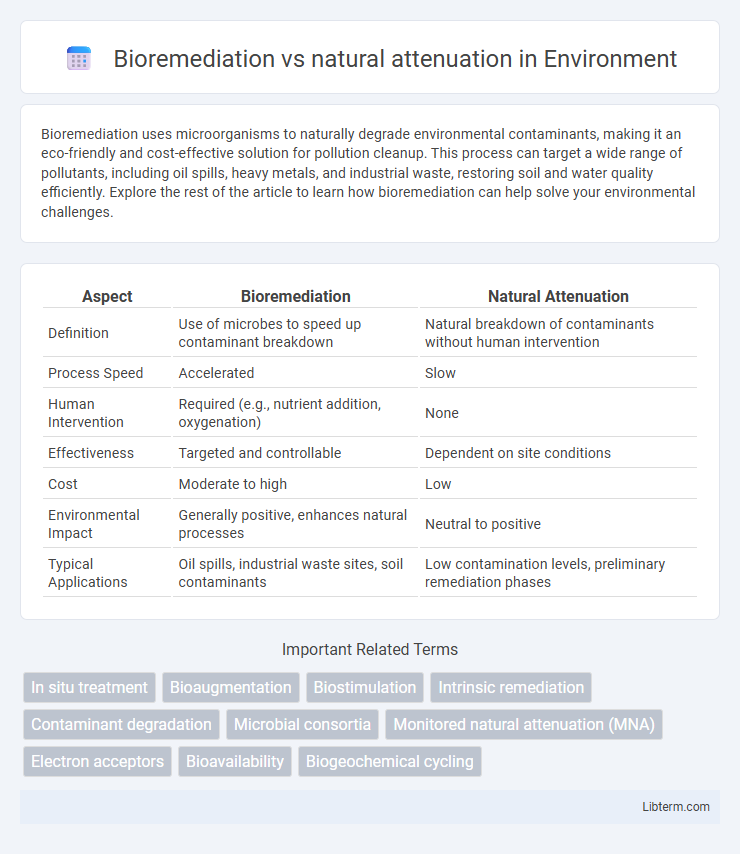Bioremediation uses microorganisms to naturally degrade environmental contaminants, making it an eco-friendly and cost-effective solution for pollution cleanup. This process can target a wide range of pollutants, including oil spills, heavy metals, and industrial waste, restoring soil and water quality efficiently. Explore the rest of the article to learn how bioremediation can help solve your environmental challenges.
Table of Comparison
| Aspect | Bioremediation | Natural Attenuation |
|---|---|---|
| Definition | Use of microbes to speed up contaminant breakdown | Natural breakdown of contaminants without human intervention |
| Process Speed | Accelerated | Slow |
| Human Intervention | Required (e.g., nutrient addition, oxygenation) | None |
| Effectiveness | Targeted and controllable | Dependent on site conditions |
| Cost | Moderate to high | Low |
| Environmental Impact | Generally positive, enhances natural processes | Neutral to positive |
| Typical Applications | Oil spills, industrial waste sites, soil contaminants | Low contamination levels, preliminary remediation phases |
Introduction to Bioremediation and Natural Attenuation
Bioremediation utilizes microorganisms to accelerate the degradation of contaminants in soil and water, enhancing pollutant removal efficiency compared to natural processes. Natural attenuation relies on indigenous microbial activity and abiotic factors to gradually reduce contaminant concentrations without human intervention. Understanding the mechanisms and conditions favoring each approach is crucial for selecting effective remediation strategies in environmental management.
Defining Bioremediation: Mechanisms and Techniques
Bioremediation involves the use of microorganisms, plants, or enzymes to degrade or detoxify environmental contaminants, accelerating natural biodegradation processes. Techniques include bioaugmentation, which introduces specific microbial strains, and biostimulation, enhancing native microbial activity through nutrient addition. This targeted approach contrasts with natural attenuation, which relies solely on indigenous microbial communities without human intervention.
Understanding Natural Attenuation: Processes and Pathways
Natural attenuation involves intrinsic physical, chemical, and biological processes that degrade, dilute, or immobilize contaminants in soil and groundwater without human intervention. Key pathways include biodegradation by indigenous microorganisms, dispersion, sorption, volatilization, and chemical transformation, all contributing to contaminant reduction over time. Understanding these mechanisms is crucial for evaluating site remediation potential and determining when natural attenuation can effectively protect environmental health compared to active bioremediation techniques.
Key Differences Between Bioremediation and Natural Attenuation
Bioremediation actively employs microorganisms or plants to accelerate the breakdown of contaminants, whereas natural attenuation relies on inherent environmental processes without human intervention. Bioremediation requires monitoring and management to optimize conditions for contaminant degradation, while natural attenuation depends on slower, passive mechanisms such as dilution, volatilization, and biodegradation. The time frame for contaminant cleanup is generally shorter with bioremediation due to its targeted approach compared to the prolonged periods typical of natural attenuation.
Advantages of Bioremediation Over Natural Attenuation
Bioremediation accelerates pollutant degradation by actively introducing or stimulating microorganisms, resulting in faster site cleanup compared to natural attenuation, which relies solely on natural processes. It offers targeted treatment capabilities, allowing control over environmental conditions such as oxygen, nutrients, and pH to enhance microbial activity and contaminant breakdown. Bioremediation also provides a more predictable and manageable remediation process with reduced long-term environmental risks and improved restoration outcomes.
Limitations and Challenges of Each Approach
Bioremediation faces limitations such as the need for specific microbial populations and optimal environmental conditions, which can restrict its effectiveness in diverse or harsh contamination sites. Natural attenuation relies on inherent microbial processes but struggles with prolonged cleanup times and uncertain contaminant degradation rates, making it less predictable for urgent remediation goals. Both approaches encounter challenges with complex contaminant mixtures and site heterogeneity, impacting their overall reliability and effectiveness in environmental restoration.
Factors Influencing Remediation Method Selection
Factors influencing remediation method selection include contaminant type, concentration, site conditions, and timeline. Bioremediation is favored for biodegradable pollutants under aerobic or anaerobic conditions, requiring sufficient nutrients and suitable pH. Natural attenuation relies on intrinsic microbial activity and environmental factors but is limited by slower contaminant degradation rates and less control over outcomes.
Case Studies: Bioremediation vs. Natural Attenuation in Practice
Case studies comparing bioremediation and natural attenuation reveal distinct outcomes based on site-specific conditions such as contaminant type, soil composition, and microbial activity. Bioremediation demonstrates accelerated degradation of pollutants like petroleum hydrocarbons and chlorinated solvents by introducing specialized microorganisms or stimulating native populations. Natural attenuation relies on intrinsic microbial processes and environmental factors, often resulting in slower remediation timelines but reduced intervention costs in cases with lower contaminant concentrations.
Environmental and Economic Considerations
Bioremediation accelerates pollutant degradation by introducing specialized microorganisms or nutrients, significantly reducing contamination periods and associated long-term environmental risks compared to natural attenuation. Although bioremediation incurs higher upfront costs for materials and monitoring, it often results in lower overall expenses by preventing protracted site management and potential regulatory penalties. Natural attenuation relies on inherent microbial activity, offering a cost-effective but slower approach with uncertain outcomes that may extend environmental exposure and liability.
Future Trends in Remediation Technology
Emerging trends in remediation technology emphasize the integration of bioremediation with advanced molecular tools to enhance microbial degradation efficiency, surpassing the slower natural attenuation processes. Innovations in genetically engineered microorganisms and sensor-driven monitoring systems are enabling real-time optimization of contaminant breakdown in diverse environments. Future remediation strategies prioritize sustainable, cost-effective solutions that combine bioremediation's active intervention with the passive, natural attenuation mechanisms for improved site recovery outcomes.
Bioremediation Infographic

 libterm.com
libterm.com